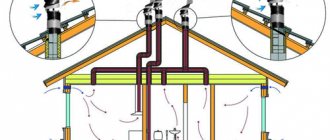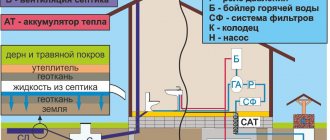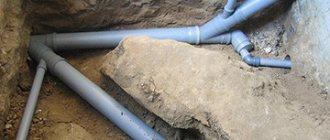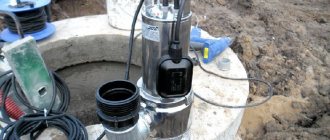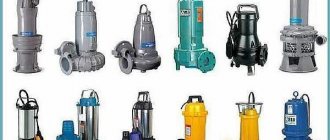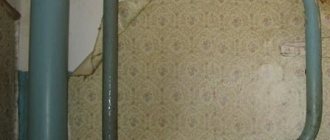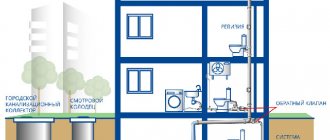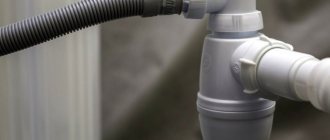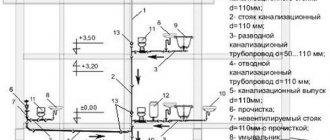When independently installing a sewer system in an individual home, not all owners have a good idea of how to install it correctly. The sewer system is an integral part of modern homes. One of the required elements of such a system for its proper functioning is a sewer pipe. Many owners of private households do not fully understand its purpose and proper use when installing a sewer system.
Sewerage and reasons for its ventilation
Not every person knows why sewerage is installed on the roof. But it is precisely because of the lack of communication between sewer pipes and the atmosphere that an unpleasant odor can occur in the toilet.
There is no need to attach caps to the outlets of sewer risers. To connect the ventilation outlet and the riser, you can use a corrugated pipe, which is equipped with an adapter ring.
Industrial and domestic sewerage networks that discharge wastewater into its external network must be ventilated through those risers in which the exhaust part is discharged through the prefabricated ventilation shaft of the building or the roof.
Why do you need sewer ventilation through the roof? Let's imagine that on the 4th floor of the house the water from the toilet tank was flushed. This content, flying through the sewer riser, creates a vacuum behind it. If there is a rarefaction zone, then the air will tend to it from all sides. And it will be good if there is an exhaust ventilation pipe. When a vacuum appears, air from the roof will quickly enter the pipe and the pressure will be balanced.
Not wanting to make holes in the roof and trying to save money, most builders simply install a cap on the top floor on the sewer riser. At the same time, there is nowhere for air to come from in the pipe, and the contents that were lowered from the 4th floor, flying past the third, will suck in water from the water seals with it. Drains and showers are more susceptible to this phenomenon, since they have a minimum water seal size.
Diagram of the use of ventilation elements on the roof of a house.
But there is a way in which the roof is not needed to lead out the pipe. This is the use of a vacuum sewer valve. After a vacuum appears in the riser, the curtain bends inside it and the valve instantly sucks in air. Then the curtain closes, thereby preventing odors from entering the room from the sewer riser. But this valve is not a very reliable device, as it can become clogged with dust or break.
Based on the above, we can conclude that the sewer outlet onto the roof is the most reliable way to ventilate the riser.
What materials is it made from?
Both the wastewater pipe and the sewer pipe are the same type of pipes. This means that they are made from the same materials - plastic or cast iron:
- Plastic ones are cheaper, more convenient to install and use.
- Cast iron is stronger and more durable, but working with them due to its impressive weight and fragility is more difficult. In addition, cast iron ones become dirty faster during operation.
Subtleties in the device of sewer ventilation
In the process of creating a ventilation outlet device for a sewer riser, experts in this field recommend paying attention to the subtleties of the work described below, presented in the form of tips.
The first piece of advice is that deflectors should not be used to equip sewer outlets on the roof. Their use, as a rule, leads to the formation of condensation, and this, in turn, leads to freezing of the deflector hole at low temperatures.
Installation diagram of sewer system risers.
The second tip says that for greater efficiency, sewer outlets should be located directly above the riser. If there is a need to connect the inlet and outlet pipes, it is better to do this using corrugated adapters.
The third tip will be related to preventing such situations when an unpleasant odor appears in the bathroom, kitchen or toilet. This situation can arise as a result of the following situation: wastewater, when moving along the riser, captures air through the hood. But at the same time, if the amount of air entering the riser is less than required by the standard, then a vacuum will be created that can cause a breakdown in the wastewater receivers of the hydraulic gates. As a result, in these rooms air appears that is not of the required quality.
The fourth tip is based on the following point. In order to get by with low costs, it will be possible to install unventilated risers. The following calculations can serve as an example for this. The working height of the riser, with a diameter of unventilated risers of 100 millimeters, should be no more than seven meters from the bottom bend of the pipe to the top. But if we are talking about installing sewer ventilation in a multi-story building, then the sewer risers must be equipped with an exhaust hood.
Requirements for a ventilated valve (aerator)
The installation of ventilated valves to allow air into the system (Figure 5), which guarantees normal operation of the sewer system, is carried out on the basis of appropriate calculations. The throughput of the aerator must correspond to the specified design parameters for the throughput of the riser. In turn, the fluid flow through the riser depends on its diameter, type (ventilated/non-ventilated) and height. The calculations also take into account the diameter of the dictating floor drain (with the highest waste flow), the angle of liquid entry through it, the height of the water seals and other initial data.
Figure 5. Operating principle of an aerator - air valve for sewerage: 1. In the operating position, the valve is closed - air from the sewerage does not enter the room. 2. When a vacuum occurs in the sewer riser, the aerator valve opens, the missing amount of air comes from the room, preventing the water seal from breaking.
In a simplified form, you can coordinate the flow parameters of the aerator and ventilated riser using tabular selections. Initially, you should refer to Appendix “B” of SP 40-107-2003 for the installation of internal sewerage from polypropylene pipes. It is to this that SP 30.13330.2012 refers to determine the characteristics of the aerator.
The largest valve with a live air flow cross-sectional area of 3170 mm2 ( Important! Look in the store not at the outer diameter, but at the size of its opening, roughly), if the design conditions are met, it is capable of compensating for decompression in risers ∅110 mm, the maximum throughput of which is indicated in table 1.
Table 1. Capacity of a riser made of polypropylene pipes ∅110 mm, equipped with a ventilation valve with a clear cross-sectional area of the air flow of 3170 mm2 and 1650 mm2.
| Diameter of floor outlet, mm | Angle of liquid entry into the riser, ° | Riser capacity, l/s | |
| 1650 mm2 | 3170 mm2 | ||
| 50 | 45.0 60.0 87.5 | 5.85 5.10 3.75 | 7.7 6.8 4.54 |
| 110 | 45.0 60.0 87.5 | 4.14 3.64 2.53 | 5.44 4.8 3.2 |
Next, you should find out the flow parameters of the sewerage system with similar initial data. For ventilated risers, they can be gleaned from tables 6-9 (SP 30.13330.2012).
Table 2. Capacity of ventilated risers made of polyvinyl chloride (PVC) pipes (SP 30.13330.2012 (Table 7)).
| Outer diameter of floor bends, mm | Angle of connection of floor branches to the riser, ° | Throughput, l/s, risers with pipe diameter, mm | |
| 50 | 110 | ||
| 50 | 45 60 87.5 | 1,10 1.03 0.69 | 8.22 7.24 4.83 |
| 110 | 45 60 87.5 | 1,10 1.03 0.69 | 5,85 5.37 3.58 |
This also takes into account the diameter of the floor outlet and the angle of its connection. From the tables it becomes clear that, for example, for some of the most popular PVC pipes today, Ø 110 mm with an outlet Ø 110mm/450 (outlet for connecting a toilet), the second throughput of the riser will be 5.85 l/s. This figure turns out to be slightly higher than with similar geometric parameters of a sewer system with an air valve (5.44 l/s (Table 1)).
Consequently , by removing the decompression pipe and installing a similar aerator, during a salvo discharge it is possible that a vacuum may occur with dehydration of the siphons.
Requirements of regulatory documentation for the vent parts of the riser
Diagram of the outlet of the vent pipe to the roof of the house.
The requirements of regulatory documentation for the vent parts of the riser include the following. Exhaust parts of the sewer system should be located at a distance of 4 meters from balconies and windows. Under no circumstances should chimney or ventilation systems be connected to the drainage parts of sewer risers.
It is allowed to combine several sewer risers with one exhaust part, and its diameter should not be less than the diameter of the riser. In most buildings, the diameter of the exhaust parts and, accordingly, the risers is 110 millimeters. It is necessary to lay the combined exhaust parts with a slope of 0.01 towards the risers.
It should be ensured that the connection of the additional ventilation riser to the sewer riser should be carried out from below, lower than the last lower device, or from above, to the branch of the oblique tee installed on the sewer riser, directed upwards. It is also necessary that this branch of the oblique tee be installed on the sewer riser higher than the sides of the sanitary fixtures or inspection holes located on this floor.
Stages of work on the installation of passage units through the roof of the roof.
Wastewater contains a larger amount of organic substances, which, in turn, rotting, begin to release harmful gases (hydrogen sulfide, ammonia, carbon dioxide, etc.), as well as water vapor that accumulates in the sewer network. There are cases in which gases from gas pipelines enter the sewer network.
Hydrogen sulfide, carbon dioxide and sulfuric acid have a particularly unfavorable effect on the concrete walls of wells and pipes. To remove these harmful substances from the sewer network, supply and exhaust ventilation is installed, which consists of fan exhaust risers of buildings and air supply devices installed above the roof.
For the manufacture of sewer structures and pipes, it is recommended to use sulfate-resistant, pozzolanic and other cements with hydraulic additives. The rate of leaching of calcium oxide hydrate, as a result of its binding with additives, decreases by 12 times.
Installation features
Installation is carried out in the following sequence:
- They begin to collect elements at the bottom point of the contour. They are connected using a tee, one hole of which is directed upward.
- A fan pipe element is inserted into the tee hole; the joint should be located above the attic floor.
- The connection point is sealed with silicone sealant.
- Every 1.5 meters the pipeline is secured to the wall with clamps.
The vent pipe, as part of the riser, is led to the roof. On a pitched roof it should protrude 0.5 m above the ridge; if the roof is in use, the distance increases to 3 m.
How to properly install a sewer riser
In this article I will talk in detail about choosing a location and installing a sewer riser in a country house. Please note: if a number is indicated in brackets at the end of a sentence, this is the number of the corresponding clause of SP 30.1330.2012 “Internal water supply and sewerage”. This document is an updated version of the relevant SNiP. If some standard is established by SP 31-106-2002 “Design and construction of engineering systems of single-family residential buildings,” this will be stated explicitly.
The riser is the main element of the internal sewer network. The main task of the riser is to collect wastewater from floor drains and divert it to a horizontal collector.
Features of repair of fan systems
Installation of the internal sewerage system is carried out “in the socket”. This greatly simplifies the process of installing and dismantling all pipeline elements.
Repair work is necessary when there is physical damage to a drain or sewer pipe. Due to the excellent rigidity (pipe bending resistance is 80 MPa) and the long service life of the plastic (up to 60 years), there is a low probability of physical damage to the pipes.
When repairing sewer pipes, the technician must take into account the following rules:
- the end of the drain pipe is positioned in such a way as to ensure effective dispersion of unpleasant odors;
- the diameter of the pipe must be the same or larger than the riser on which the installation is being carried out;
- lay the pipe in warm rooms, and complete the installation in a cold zone, since the temperature difference provokes a pressure difference in different sections of the pipe.
Repair work involves connecting a waste pipe to a sewer riser. At the same time, vacuum valves are installed on other risers - rubber seals equipped with springs.
Replacement and repair of drain pipes must be carried out according to design documentation, taking into account the rules for installing risers in the sewer system
During operation, the sewer system creates a vacuum in the valve, as a result of which it opens and sucks air from the room. After stabilizing the pressure in the riser, a special spring automatically closes the check valve, preventing the unpleasant odor from escaping into the atmosphere.
Choosing a location for the riser
When building a private house, the place for the riser is selected as part of the creation of internal sewerage projects. When choosing a location, remember that:
- side branches should be as straight as possible (8.2.2);
- the riser should also be as straight as possible, but the creation of indentations (horizontal displacement of the riser) is also allowed if certain conditions are met;
- a riser made of polymeric materials (PP, PVC, HDPE, LDPE pipes) must be located hidden inside a shaft or box, the walls of which are made of non-combustible materials (except for the door that provides access to the riser. The door is made of a material with a flammability class of at least G2) – ( 8.28);
- in basements where there are no production or storage facilities, in attics and in bathrooms, risers made of polymer pipes can be located openly;
- Open installation of risers in residential premises is not allowed.
Riser offset
It should be remembered that:
- the horizontal offset should be no more than 1 m;
- to create an indentation, bends with an angle of no more than 45° should be used;
- the diameter of the indent branches must be no less than the diameter of the vertical pipe.
If the horizontal offset of the indentation must be more than 1 m or the outlet angle must be greater than 45 (this is hardly possible when creating a sewer system in a private house, but who knows), the speed of water movement in the indentation area must be at least 0.6 m/sec, and the riser below the indentation should have a diameter comparable to the diameter of the horizontal collector.
Installation of indents above bends is undesirable, but is allowed if:
- the section of the riser located below the indentation can operate as unventilated;
- the section of the riser located below the indentation is equipped with a ventilation pipeline or ventilation valve (8.2.3).
Sometimes offsets are created to reduce flow speed and noise levels. In this case, the indentation should look like this:
Do I need to insulate and soundproof?
It is not at all necessary to insulate sewer pipelines passing through residential premises, as well as sewer pipelines. But in an unheated attic it is worth making at least minimal thermal insulation of the pipes so that during severe frosts the ice does not freeze inside, since water vapor is much lighter than air, and they will tend to rise up the pipe, where they will freeze on the cold walls.
Insulated pipe
Sound insulation of the drain pipe must be carried out only if it passes openly through residential premises. If this cannot be avoided, then the insulation work is quite simple and is carried out in the same way as for all sewer pipelines with the same ease. The only thing that complicates the process is the variety of acoustic processes in pipes, which directly depend on the materials from which the pipelines are made.
Thus, the sound insulation properties of cast iron pipes are much better than those of their plastic counterparts. This is due primarily to the properties of the granular structure of cast iron and the larger wall thickness, so such pipes, as a rule, do not require additional sound insulation.
Sound processes occurring in plastic pipes can be divided into four main components:
- Impact nature, when falling water and feces repeatedly hit the walls of the riser;
- Atmospheric nature is the penetration of wind and precipitation noise through the outer part of the pipeline;
- Resonant nature from the presence of extraneous noise in the pipes caused by the interaction of the sewer pipeline with the building structures;
- Vibrations that occur when there is contact with any operating equipment.
Sound insulation of a drain pipe
The main part of the work on sound insulation should be carried out at the design stage of a residential building, so that all sewer risers do not pass through residential premises and are installed exclusively in special boxes or sewer shafts, which themselves are shielding devices and prevent the spread of noise .
If, after all, the vent pipe is located open in a living room, then it can be easily soundproofed by wrapping the pipe with strips of inexpensive polyethylene foam in two or three layers.
Choosing a pipe for the riser
You can find information on different types of pipes in the corresponding section. Polypropylene pipes are most often used.
It is also important to correctly determine the diameter of the riser. The throughput capacity must be sufficient to simultaneously drain wastewater from all connected floor drains. To calculate the risers of multi-story buildings with a large number of connected devices, a complex formula is used. For a private home, you can use a simplified calculation algorithm that takes into account only the total flow of wastewater from different appliances. Read more about calculating the diameter of the sewer riser.
Conclusions and useful video on the topic
Thoughtlessly venting the attic is not a good idea:
Guidance for the installation of ventilation components in a gable or gable roof:
Features of the design and operation of natural ventilation in the attic:
Properly organized ventilation in the attic floor and in the unheated attic space will ensure a normal microclimate in the residential area and extend the service life of structures.
However, building codes must be followed when venting all venting components into the attic. Along with the exhaust air, condensate must be completely removed, from which elements made of wood and metal suffer almost equally. They lose their load-bearing capacity due to moisture.
Tell us about how and in what way the ventilation was removed through your own attic or attic. Share useful information on the topic of the article that will help interested site visitors. Please leave comments in the block below, post photos on the topic, and ask questions.
Ventilated and non-ventilated riser
Sewer gases constantly accumulate in sewer systems. They can be toxic or explosive, and they certainly smell bad. To prevent these gases from entering the premises through receivers, sanitary fixtures are equipped with hydraulic shutters. A valve is a bend in a pipe that contains water inside. Water does not allow gases to enter the room.
With the intensive passage of wastewater through the riser, a vacuum is formed in it. If the vacuum exceeds the threshold limit, water from the water seals will be drawn into the riser - a so-called water seal failure will occur. Sewage gases, not meeting water, will freely enter the room.
At the same time, installing a ventilation or drain pipe allows you to avoid vacuum and ensure the removal of sewer gases into the atmosphere. The drain pipe is a continuation of the riser - it leads to the roof. A riser with a vent pipe is called ventilated, without a vent pipe - unventilated. An unventilated riser is also considered to be a riser equipped with a ventilation valve or a group of 4 or more risers, which are connected at the top by a common pipeline without an exhaust part. The term “fan boner” is generally used haphazardly.
The exhaust part of the riser is discharged through the roof or through a ventilation shaft. The height of the exhaust pipe above the roof should be:
- on flat and pitched unused roofs - at least 20 cm;
- above the edge of the ventilation shaft - at least 10 cm;
- on exploited roofs - at least 3 m.
In addition, the distance between openable windows or balconies and the outlet of the ventilation pipe must be at least 4 m.
The diameter of the riser ventilation pipe must be equal to the diameter of the main pipe (8.2.16). If the exhaust pipe combines several risers, its diameter must be equal to the diameter of the largest riser from the combined group (8.2.17).
When laying in unheated attics, the exhaust pipe must be insulated.
Important: it is forbidden to install deflectors that impair draft at the mouth of the riser exhaust pipe - it will freeze in the first frost.
If you do not have the opportunity to install a vented riser, you can make it unvented. Installation of unventilated risers is allowed if:
- the ventilation mode of the external sewer network is maintained;
- the second flow rate of wastewater does not exceed the throughput capacity of an unventilated riser of the appropriate height (see data on the throughput of unventilated risers in the reference materials).
The number of floors of the building does not matter, although the old edition of SNiP had slightly different requirements (SNiP 2.04.01-85). At the same time, I strongly recommend installing normal ventilation of the riser.
An unventilated riser must end with a revision or a cleanout hatch.
Installation of revisions
Risers must be equipped with inspections. Audits should be installed on the upper and lower floors (8.2.2), and if the height is more than 5 floors, every three floors (8.2.3). If the riser is made with an indentation, there must be a revision on the floor that is located above the indentation of the riser. In a one-story private house one revision is enough, in a two-story one too (on the second floor).
The inspection is located at a height of 1 meter above the floor level. The storey side outlet must be under inspection. The distance between the connection point and the revision is at least 150 mm.
What it is
When a private house is built, it is necessary to connect various communications to it. One of them is sewerage. At first glance, you might think that it is enough to equip it with only a sewer drain. In fact, this is not enough.
In order to explain the purpose of the vent riser, you need to remember how the toilet flushes in more detail. After the sewage is drained, a certain amount of water then gets there. Some of it remains in the toilet. It is actually a water seal, the role of which, in particular, is to prevent the unpleasant odor from the drains from entering the living quarters. It is important to understand that this protective layer of water is located inside the toilet.
If several such plumbing fixtures are installed in the house, then each of them, which is not currently in use, has such a water seal.
When one of the toilets is flushed, the pressure drops for a short period of time immediately after the sewage and drained water flows out. Since all the others are connected to this pipe, their water seals are broken and an unpleasant odor penetrates into the premises.
Diagram of the design and operation of the sewerage ventilation system Source profidom.com.ua
It is important to note that this situation exists not only in relation to toilets, but to all drains that are connected to the sewer system. For example, we can talk about a water seal in a bathroom or in a sink, if they are connected in the specified way.
This situation could have been avoided if the pipe had an additional outlet through which air could freely flow into it. In this case, low pressure would not arise at the drainage point and the water seals would not be broken anywhere.
Odors from the sewer could also escape through such a pipe. A sewer riser is a pipe that performs the specified functions, which is connected to the sewer system of the house and led outside it.
How necessary is it? In fact, the system in question is actively used in apartment buildings. In the sewer system, drainage from apartments occurs in a vertical pipe.
A system of vertical sewer pipes that performs the function of a drain riser Source ar.decorexpro.com
Its lower end is connected to the drainage system, and the upper end is brought out onto the roof and actually serves as a drain riser.
How to properly install a riser in a private house:
About riser clamps and sound insulation
A significant part of the noise from a working sewer riser is associated with the transmission of vibration to the walls through the clamps holding the pipe. This problem can be solved by using a damping clamp with a rubber insert.
Passing the sewer riser through the ceiling
As noted above, there should be no joints where the riser passes through the ceilings. For the obvious reason - a leak in the riser most often occurs through a joint, and if it ends up inside the ceiling, this is a problem.
After installing the riser, the passage through the ceiling is sealed with cement to the entire thickness of the ceiling (8.2.8). In addition, it is necessary to protect the lower part of the riser with concrete to a height of 8...10 cm. The thickness of the concrete layer is 2...3 cm.
Before sealing the riser with concrete, it is necessary to wrap the pipe with rolled waterproofing material. There should be no gaps in the waterproofing protection.
Sound insulation of sewer riser
If you are bothered by riser noise, you can use polyurethane foam or foam shell. Polyurethane foam is more expensive, but its flexibility allows you to effectively insulate curved sections of pipes. Foam shells are only suitable for straight sections, but they are noticeably cheaper. In addition, working with foam soundproofing for pipes is very simple - apply it, snap it on, and secure it with tape.
I do not recommend using foamed polyethylene as a material for sound insulation - it is cheap, but very short-lived. Polyurethane foam is completely useless - it practically does not absorb sound.
Passage of a sewer riser through the roof
The ventilation part of the riser must be brought to the roof. Standard roof penetrations can be used to penetrate the roof. The choice of passages for pipes with a diameter of 100, 110 and 150 mm is large - there will be no problems with the purchase.
In addition to the penetration, I recommend buying an insulated sewer outlet - especially if you are building a house in Moscow, the Moscow region or even further north.
The work itself is carried out in the following sequence:
- remove the thermal insulation at the site of the intended passage through the roof;
- we look for the area between the sheathing elements and mark the middle of this area;
- drill a through hole of small diameter at the location of the expected center of the output;
- we move to the roof and cut out a hole of the desired shape in the roof (use a stencil);
- We apply the sealing element of the penetration to the roof and adapt it to the topography. The element bends easily, so it can be pressed tightly even to a roof with complex terrain;
- We fix the seal using non-acetic sealant and self-tapping screws. The distance between the screws is 3.4 cm;
- if the axes of the sewer outlet and the main element of the ventilation pipe do not coincide slightly, we attach a special corrugated pipe to the sewer outlet. If the discrepancy is significant, you will have to install an inclined element;
- We attach the roof penetration to the sealing element. The method of fastening depends on the design of the penetration.
Please note: the remote elements of the ventilation pipe must be inclined. The minimum slope is 2 cm per 2 m length. This is necessary so that the condensate can freely roll down and fall into the drain.
- We insert the sewer outlet into the penetration and fix it. The output must be positioned strictly vertically;
- we return to the attic and attach the water seal seal to the waterproofing (supplied with the roof penetration);
- We connect the corrugated pipe or the outlet of the sewer riser to the waste pipe using a clamp.
Ventilating a Cold Attic
Ventilating a cold attic can be done easily with your own hands. This will require knowledge of a little theory and some practical skills. Providing sufficient ventilation in a cold attic will not cause any particular difficulties due to the large air volume and the absence of barriers to normal air circulation. Air exchange can be carried out through the eaves, ridge and ridge of the roof, as well as gable windows and grilles.
For gable roofs, ventilation of cold attics is done either through gables or through loosely fitting wooden lining of eaves overhangs. If the gables are made of stone, then holes can be made in them for dormer windows with ventilation grilles.
Dormers should be installed on opposite sides to ensure proper ventilation of the attic.
There is an alternative, more economical option. To do this, install standard ventilation grilles (pediment vents), one of which is adjustable, and the other is turned with the vents down. To protect against insects, this grille is equipped with a protective mosquito net.
Hip roofs do not have gables due to the shape of their structure, so for them there is another option for providing ventilation in the attic - using eaves overhangs. The air flow will be through the roof lining, and its exit will be from above at the ridge. If the filing is made from wood with your own hands, then small gaps are left between the bars for the passage of air. When covering the cornice with plastic soffits, such a procedure is not necessary, due to the presence of pre-made holes on the elements - perforations.
The air exits from above, through the roof ridge. Its design features depend on the type of roofing material used. As a rule, any manufacturer of roofing materials has its own ready-made and practical solutions
!
Valleys (valleys) are one of the problematic and difficult areas of the roof. To ensure normal ventilation of the attic space, point aerators are installed along the valley. However, this method is acceptable for roofs with slope angles of 45° or more.
. On flat roofs, there is a high probability of snow accumulating in the valley area and therefore such ventilation becomes ineffective in winter. You can combat this by installing forced ventilation - inertial turbines, roofing electric fans, or using high nozzles that will not be covered with snow.
Operating principle of a fan pipe
The fan pipe is a structural element that connects the pipeline with a specially constructed ventilation duct. Its key purpose is to remove gases and odors from the sewer system.
The length and shape of this element can be arbitrary. There are models of vertical and horizontal design, beveled at right or acute angles.
The principle of operation of the vent pipe is simple. Wastewater entering the vertical riser creates a vacuum in the pipeline cavity. It can be partially compensated by water, which acts as a hydraulic damper in the siphons of installed plumbing fixtures.
But if the vertically installed riser has a large length and at some point there is a one-time powerful discharge of waste liquid, then a vacuum arises in the sewer pipe. The formed piston from the liquid with all its strength and characteristic “smacking” sound at one moment tears off and breaks through the hydraulic valves of the plumbing, emptying the siphons.
As a result: water is completely sucked out of all water seals. Therefore, there are no obstacles to sewer “odors”. Due to this, they quickly spread throughout the building.
The trouble is that the matter is not limited to the appearance of an unpleasant “fragrance” in living rooms. The natural process of decomposition of feces is accompanied by the release of gases harmful to households: methane and hydrogen sulfide.
If the system is equipped with a fan riser, at the moment of “throwing in” there are no such consequences, since the vacuum created in the collector simply does not have time to break through the hydraulic valves in the siphons. This is prevented by flows of atmospheric air, which, simultaneously with the occurrence of vacuum, are drawn into the system, blocking the penetration of gases into the room when draining and pumping out the septic tank.
General information
The mass of sewage that arises during the flushing of wastewater into the system, entering the main line, acts like a pump. Before the drain, the pressure indicator increases, and after them it decreases.
If the ventilation section of the line is not provided during use, the water seal will fail. Air mass is sucked through the drain hole of plumbing fixtures. The effect allows gases to enter the building.
This problem happens with devices with a weak water seal. But sometimes a breakdown occurs in several areas at once. It is accompanied by characteristic gurgling sounds appearing in the drain holes.
If the line is equipped with a ventilation section, air enters the line absolutely freely.
Due to this, the pressure indicator stabilizes. There is no failure of the water seals. Accordingly, the smell of sewage does not penetrate into the room.
Conditions for installing a fan riser
According to the current building codes 2.04.01-85*, and in particular the section “Internal water supply and sewerage of buildings”, an element such as a drain pipe must be installed in the following cases:
- In one-story buildings, if they have swimming pools and other structures that are capable of discharging single portions of large volumes of wastewater.
- When installing sewer risers assembled from pipes with a diameter of 50 mm.
- In low-rise buildings, provided that each floor is equipped with a water supply and wastewater disposal system.
The easiest way to determine whether installation of a fan riser is required for specific conditions is to focus on the maximum volume of a single portion of wastewater.
In multi-storey buildings, where communications are connected to each floor and each apartment, the installation of a vent riser is a strict condition. In this case, the riser is installed on the roof of the building.
Types, sizes and diameters
There are 2 types of fan pipes:
- Straight-line (hard).
- Offset (corrugated).
The offset pipe is mobile and allows you to connect to a toilet with any outlet location.
The standards regulate the diameter of vent pipes at 110 mm. This value is the same for both cast iron and plastic models.
The length of the vent pipe can be different: it depends on the height of the ceiling and attic spaces, as well as the level of the outlet beyond the roof.
Which type is better
Cast iron is gradually giving way to plastic, so if possible it is better to replace the cast iron model with a plastic one. This is not at all difficult to do: you can use special lip adapters for insertion.
When choosing between plastic products, give priority to polymers based on polypropylene (PP) or polyvinyl chloride (PVC). They:
- Provide sufficient fastening rigidity and resistance to vibration and mechanical loads.
- Able to withstand the aggressive environment of condensate accumulating on the walls of the pipeline when foul-smelling gases are released.
It is better to use the same type of plastic that was chosen for the main sewer. This will make it easier to select a sealing compound.
Design features are determined by the installation method and the personal preferences of the owner. If the design is rectilinear, it is wiser to use rigid products. If you plan to bend the contour, it is allowed to make some of the elements in corrugation.
How to choose the right one
The main question in choosing a drain pipe is determining the optimal diameter, especially when it comes to apartment buildings with a large number of drains.
The cross-sectional size of the sewer pipe should not be less than the same value of the interfloor sewer riser to which it is connected.
approximate price
The cost of fan pipe products is determined by a number of parameters:
- Dimensions (section, length, wall thickness).
- Material of manufacture.
- Design features.
- Manufacturer and brand awareness.
The approximate cost of PVC models is given in the table:
| Outer diameter, mm | Wall thickness, mm | Pipe length, m | price, rub. |
| 90 | 5 | 3,06 | 500 |
| 90 | 8 | 6 | 1850 |
| 113 | 5 | 2,07 | 560 |
| 113 | 5 | 3,07 | 830 |
| 113 | 5 | 5,07 | 1360 |
| 113 | 7 | 2,07 | 760 |
| 113 | 7 | 3,07 | 1125 |
| 113 | 7 | 5,07 | 1855 |
| 125 | 5 | 2,07 | 605 |
| 125 | 5 | 3,07 | 900 |
| 125 | 5 | 5,07 | 1480 |
| 125 | 6 | 3,07 | 1050 |
| 125 | 6 | 5,07 | 1735 |
| 125 | 7,5 | 3,07 | 1320 |
| 140 | 6,5 | 2,07 | 890 |
| 140 | 6,5 | 3,07 | 1320 |
| 140 | 6,5 | 5,07 | 2180 |
| 140 | 8 | 3,07 | 1600 |
| 140 | 8 | 5,07 | 2630 |
| 165 | 7,5 | 3,07 | 1740 |
| 165 | 9,5 | 3,07 | 2150 |
| 195 | 8,5 | 3,08 | 2195 |
| 195 | 11,5 | 3,08 | 3050 |
| 225 | 10 | 3,09 | 3170 |
| 225 | 13 | 3,09 | 4005 |
Features of installation activities
The technology for installing a fan riser is quite simple. Even a novice master can perform the installation work.
Selection of required materials
The three key elements of the ventilation system are the drain pipe, the valve and the water seal. Each of them ensures equal pressure in the system.
Siphons with a water seal are installed at the stage of installation of indoor plumbing fixtures.
The drain riser acts as a continuation of the sewer pipeline. And to arrange it, you can use the pipes used in assembling the main system. For installation of the ventilation duct, it is best to choose plastic pipes. They do not freeze, are not subject to the destructive effects of moisture and are resistant to corrosion.
When installing a sewer system, polymer products are also advantageous because, due to the smoothness of the walls, they do not produce noise when wastewater passes through the pipeline.
When deciding on the size of the drain pipe, you should be guided by the rule that the throughput of the 50th pipe is almost 16 times less than the 110th. Using D 50 mm pipes, you will not get an effective ventilation system, but a useless set of connecting pipes.
Regardless of the design and location, each drain pipe is equipped with a check valve. After all, even if the pipeline was initially laid correctly, due to insufficiently reliable fixation of the pipes on the walls and under the influence of the natural process of shrinkage of the building, its slope may change.
If the ventilation malfunctions, air will flow into the sewer drain from the nearest plumbing fixture. Most often, it becomes the element of sanitary ware that has the smallest water seal.
Each valve is equipped with inlet and outlet pipes. An air-filled ball is located in the cavity of the device. At the moment a vacuum is created, it presses on the membrane, which completely covers the chamber. Due to this, gases simply cannot enter the pipe cavity.
In addition to its main function, a check valve helps solve two key problems:
- prevents wastewater from returning to plumbing fixtures;
- protects the system from the ingress of large mechanical impurities and rodents from penetrating the system.
But in order for the air valve to cope with the task assigned to it, it must be placed only in those rooms where the temperature is constantly above zero.
General installation recommendations
The main rule when arranging the system is that the starting point is placed in the heated part of the building, where the temperature is above zero at any time of the year, and the final point is in the cold part. This solution allows us to provide the necessary temperature difference, creating conditions for the uninterrupted removal of “aromas” outside the building.
The vertical riser should be led directly to the roof of the building. The attic space is not suitable for these purposes, since the draft will be weak and the attic “stinks.”
When installing a drain pipe, it is important to adhere to a number of basic principles:
- The outlet of a riser equipped with a waste pipe must be placed separately. According to clause 17.19 of the building codes, it cannot be organized together with a stove chimney or ventilation system.
- When placing a structural element on a pitched roof, it is placed at a height of 500 mm, positioning it as close as possible to the ridge. If the roof is flat and, moreover, unused, then the height of the exhaust part should be 300 mm.
- The horizontal distance of the vent pipe installed above the roof relative to the balconies and opening windows in the house should be about 4 meters.
- Do not place the exhaust pipe under the eaves. With this arrangement, traction is reduced.
In a situation where the roof is actively used and other objects are placed on it, then the height of the riser outlet should be at least 3 meters. Provided that the duct is equipped in a prefabricated ventilation shaft, it is placed at a distance of 100 mm from the edge.
Several risers can be combined simultaneously within one drain pipe. But, in any case, since with such an arrangement the ventilation is not forced, but gravity-fed, it is advisable to avoid turns and various kinds of narrowing of the pipeline. Their presence may create unwanted resistance to air flow.
If the exhaust part is slightly offset relative to the riser, the structural elements can be connected with a corrugated plastic sleeve.
When installing a riser equipped with a vent pipe on the roof, there is no need to erect auxiliary exhaust devices in the form of a weather vane or deflector, as well as protective “mushrooms”. This point is clearly stated in paragraph 18.18 of the current SNiP.
The use of these devices can, on the contrary, have the opposite effect: the condensate formed when the ambient temperature drops will freeze and block the outlet openings. The deflector will be effective only in a situation where the building is located in an area with a warm climate.
How to connect a check valve
The vent pipe is connected to a pre-equipped ventilation duct. If the ventilation scheme requires the presence of too few outlet risers, the fan pipe can be routed separately through the nearest wall, placing the outlet element horizontally in its upper part. To do this, it is brought through the wall opening, leading outside the building to a distance of 30-40 cm.
The ventilation valve is mounted in the free end of the pipe or socket. The main thing is that the section of the pipe on which the valve will be installed is located above the highest point of drainage from the plumbing equipment.
When placing the element internally, it is necessary to clean the section of the pipe where the valve will be installed and treat it with a degreasing compound.
A special insert is buried inside the pipe, which can be purchased at any hardware store. The valve is recessed into the insert, placing it in the opposite direction of the flow of waste. It is positioned in such a way that the petals of the device bend towards the plumbing.
When installing a drain pipe with a cross-section of 110 mm, the check valve is connected using an adapter.
An important point: all operations for installing a vent pipe should be carried out on dry surfaces. At the stage of fixing the check valve, you should not use silicone sealants or any kind of lubricant.
Use of cast iron elements
For several decades, the installation of exhaust ducts took place using cast iron risers. Today, cast iron fan pipes are becoming increasingly rare. But in vain, because using risers made of this material you can be sure of the quality of the exhaust and ventilation ducts. Cast iron parts have a number of advantages.
They differ:
- strength. The rigidity and density of the alloy contribute to the safe operation of cast iron products, which can be purchased at a hardware store. They are used in the construction of private, multi-storey buildings;
- long service life. This is due to high wear resistance, which helps metal products maintain excellent technical characteristics for many years;
- resistance to mechanical impacts. They are not afraid of accidental impacts, damage, or heavy loads.
Minuses:
- tendency to corrosion processes;
- difficulty of transportation;
- heavy weight;
- high price.
When repairing or replacing old cast iron risers, it is necessary to dismantle the existing system. It is not easy to do this if the sewer or exhaust line is located in a hard-to-reach place. How to disassemble a cast iron pipe behind a toilet? It is difficult to carry out this procedure if tow with cement, aluminum or sulfur were used to connect the risers.
First you need to dismantle the parts that are located further from the riser. To do this, you should stock up on a chisel or a hammer with a plastic or rubber head. When you hit the chisel with an iron hammer, pieces of metal sharply bounce off the pipe and can fall into the riser, since cast iron is a very brittle alloy.
Having completed all the preparatory work, proceed to removing the cast iron drain or sewer riser:
- After destroying this element of the system, gradually approach the crosspiece, leaving 30-35 cm of an almost broken part.
- Using the remaining piece, gently loosen it. If this does not help, then use a chisel to start removing the packing, loosen it again, and then remove the remaining fragment.
- If the system is sealed with sulfur, then you need to take a blowtorch or gas torch and start heating the packing. Before doing this, you need to cover the furniture and walls with a screen so as not to damage them. It is advisable to carry out this work together, since one person must remove the heated, viscous sulfur.
- After removing a certain amount of the heated mass, remove the remainder of the unnecessary part of the part.
An option is possible when you can use a grinder to cut off the rest of the line right up to the socket. This procedure will ensure not only a neat cut, but also a quick, convenient joining of the new plastic sewer part with the old cast iron riser.
Important! The cast iron fan pipe can be used in any extreme situations. This means that such a system will function normally under conditions of a wide temperature range at elevated pressure.
Work with cast iron sewer or sewer pipes, including drilling them, must be carried out with the utmost care. This is due to the increased fragility of the metal.
Over a long period of operation, as a result of corrosion processes, cast iron sewer risers become unattractive. Therefore, they need to be refreshed. How to paint a cast iron pipe in a toilet?
For painting use acrylic, water-dispersion paint. The shade can be very diverse.
Some owners refresh cast iron risers with oil paints. Before painting, you need to get rid of rust, old peeling paint, unnecessary debris, and dirt. Only after such preparation can you begin painting. A painted, restored sewer line will last for many more years.
Types of products
The classification of fan pipes into types is carried out according to the materials of manufacture, according to which polymer and cast iron products are distinguished. Cast iron, by and large, is practically not used now - it is a relic of the Soviet era; such solutions can be found in multi-storey buildings in which major sewerage repairs have not been carried out.
The cast iron fan pipe has a number of serious disadvantages, the main ones being heavy weight, high cost, and labor-intensive installation. In terms of performance characteristics, it is completely inferior to plastic products; its only advantage is durability and high mechanical strength.
A plastic sewer pipe can be made from two types of polymers - low-density polyethylene (HDPE) and polypropylene (PP). We recommend using products made from HDPE - this is one of the most rigid types of plastic, which has high crack resistance and resistance to deformation.
Let's consider the advantages of plastic fan pipes:
- minimum cost;
- low weight and, as a result, ease of installation;
- durability – service life over 50 years;
- resistance to chemically aggressive substances;
- resistance to corrosion.
Note that due to the perfectly smooth inner surface of the pipe, with rare exceptions, it does not need sound insulation, since the sound of air circulating through the system is not audible.
Basic noise insulation is carried out by installing the line using damping clamps with a rubberized fixing ring that dampens vibration. If practice shows that the fan pipe produces a lot of noise, sound insulation can be made using sleeves made of foamed polyethylene or mineral wool.
Installation and replacement
The fan pipe is installed so that the lower part of the riser is placed in a heated room and the upper section is exposed to the open air. In this case, the pressure drop caused by the temperature difference will ensure effective removal of sewer gases.
When installing a drain pipe, you must follow the following rules:
- You cannot use a drain pipe whose diameter is smaller than the diameter of the sewer riser (standard – 110 mm);
- if a plastic pipe is connected to an old cast-iron riser, a rubber adapter must be installed at the junction to ensure the tightness of the entire system;
- several risers of an apartment building can be connected to one fan ventilation channel using adapters and bends; in this case, the horizontal parts of the line must be laid with a slope of 2% from the plumbing fixtures;
- the minimum distance between the roof of the building and the upper opening of the drain pipe is 30 cm; if the attic of the building is used as a living space, the distance increases to 3 meters;
- the outlet point of the waste sewer pipe should be 4 meters away from the nearest balcony;
- when installing plastic products in places where they pass through the concrete floors of a house, steel sleeves must be installed;
- It is strictly prohibited to combine fan ventilation and smoke exhaust into one channel;
- It is necessary to install a fan fungus on the outlet hole, which will prevent insects and leaves from entering the system.
Fan pipe on the roof of a house
Replacement of drain pipes in multi-storey buildings is carried out by responsible representatives of housing and communal services, since the drain part of the sewer system is located outside the residents' apartments.
You can repair the riser yourself, the cast iron parts of which can rot during operation and cause serious problems in the apartment. Repairs must be coordinated with neighbors higher up in the house, who must not use the bathrooms during the period of replacement of areas.
Sewer riser replacement technology:
- The water supply to the toilet is shut off and the toilet drain hose is removed.
- The toilet is dismantled, the room is cleared of foreign objects.
- Using a hammer, chisel and grinder, the damaged part of the riser is dismantled - this is an extremely labor-intensive process that can take more than one hour of work.
- Rubber cuffs are installed on the end parts of the old riser, secured with sealant.
- A new riser is assembled from plastic segments with a diameter of 110 mm, which is equipped with an additional socket for connecting drain pipes from the toilet, bathtub and sinks.
- Plumbing fixtures are supplied to the riser via corrugated plastic pipes installed with a slope of 5 in the direction of the drain.
Installation sequence
Installation of the drain pipe should be carried out only after familiarization with the design. The installation of this element should be considered at the design stage of internal utilities. For better ventilation performance, it is recommended to make fewer bends and slopes in the system.
Ideally, a sewer riser installed in a private house should be in a vertical position. The pipe is led out, bypassing the ceilings, straight to the roof. But, as practice shows, this is not always possible. In the case of some country houses, the use of additional elements for connection is required.
It is also practiced when several risers are connected to one air duct. Installation of such a plan is more in demand, since thanks to this, air pressure is evenly distributed throughout the system.
climate control equipment or with a carbon monoxide removal system
It happens that the air riser breaks and the drain pipe needs to be replaced. The principle of operation is similar to how other parts of the system are repaired. The main difference is the materials from which the elements were made and how they are connected.
Replacement of an element must be carried out subject to certain conditions:
- When dismantling work is carried out, the house must have good ventilation.
- When starting to replace an element, you should wear a respirator and rubber gloves.
- After completing the work, you should make sure that the system remains tight.
If different materials are combined, for example, plastic and cast iron, it is important to use a rubber adapter.
The fans are connected at angles of 45 and 135 degrees. The horizontal section should have a slope of 0.02% in the direction where the gases escape.
Metallurgical products
Metal devices, when arranging sewage systems in private and apartment buildings, have been used for a very long time, but have not lost their relevance today, due to the following positive characteristics:
- cast iron alloys have a high level of strength, and the rigidity and density of the metal structure allows for safe and uninterrupted operation of the drain pipe for a long time;
- increased wear resistance allows the use of metal fan pipes in regions with unfavorable climatic conditions;
- the material is very resistant to mechanical damage and can easily withstand even significant external loads;
- metal fan devices are impervious to ultraviolet rays and are suitable for installation for long-term operation in open space conditions.
The disadvantage inherent in any metal sewer drainage devices is their susceptibility to corrosive changes, to prevent which special treatment of the material is carried out.
Protective treatment can be galvanizing or spraying.
Among other things, such pipes, as a rule, have significant weight, which complicates transportation to the installation site and installation.
The main disadvantages are considered to be the high cost of metals, the need to purchase special fittings and the use of special equipment during installation.
Why extend the riser to the roof?
Figure 1. Sewage system in an apartment building: 1 - Exhaust ventilation pipe; 2 - Riser; 3 - Bath; 4 - Washbasin; 5 - Sink tank; 6 - Toilet; 7 - Outlet pipe; 8 - Revision; 9 - Sink or sink in the kitchen; 10 - Hydraulic valve; 11 - Floor siphon; 12 - Issue; 13 - Inspection well from the yard network; 14 - Yard network; 15 - Control well; 16 - Connecting well; 17 - Inspection well of the street network; 18 - Street network.
Of course, we will talk about the ventilated part of the sewer riser - the decompression or vent pipe. It is designed to serve as a connecting element between sewer communications (centralized or local) and the atmosphere. The vent pipe helps solve two extremely important problems:
- Compensation for decompression, that is, the vacuum created by the flow of waste liquid moving inside the pipe (Figure 2.1). The magnitude of the vacuum can reach emergency thresholds, at which water is sucked into the sewer from the water seals of sinks, shower trays and even toilets. Of course, decompression may not reach a critical level with insignificant water removal. However, during large volley discharges from several plumbing points, the waste flow can almost completely block the cross-section of the pipeline. Such a water “piston”, falling inside the riser at high speed, will cause a significant decrease in pressure in it. The result is broken water seals of siphons, which cuts off direct access of harmful stench from the sewer to the premises.
- Free removal from sewers of gaseous products resulting from the breakdown of human waste (Figure 2.2). Conditions of abundant moisture, heat and organic matter are almost ideal for the development of a variety of microorganisms. When processing organic raw materials, they release significant volumes of gases such as methane and hydrogen sulfide. Their concentrations in a confined space are fire and explosive, and accidental entry into a living space can pose a serious threat to human health.
